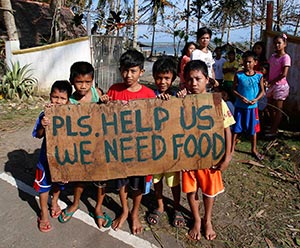MANILA, Philippines — Tropical Storm Hagupit dumped heavy rain as it slunk its way to the Manila area Dec. 8, after passing across the northern half of the central Philippines at typhoon strength. Children display a sign asking for food from motorists by the side of a road in Dolores, Philippines, in Eastern Samar province, Dec. 8. (CNS photo/Erik De Castro, Reuters)
Children display a sign asking for food from motorists by the side of a road in Dolores, Philippines, in Eastern Samar province, Dec. 8. (CNS photo/Erik De Castro, Reuters)
The Philippine Red Cross said at least 21 people died because of the storm. Most of them were in Eastern Samar, the province that took the first hit from the Category 3 typhoon.
Hagupit first hit Dec. 4 and, with greatly diminished winds, torrential rains and flooding have been a major concern.
Several towns on Samar Island bore the brunt of Typhoon Hagupit, which brought roof-high flooding, left debris and knocked down power lines.
On Dec. 8, the military was able to send a C-130 plane bearing relief goods to Borongan, a hard-hit city in Eastern Samar. The Philippine Red Cross also was able to get into Borongan on the same day and start its assessment, but the agency was still struggling to get to tiny, far-flung islands off the Samar provinces’ northern coast.
Red Cross Disaster Manager Roderic Salve said bad weather kept a ship with provisions from going to the remote islands.
“It’s still raining. That’s a problem … intense rains and strong wind,” he said.
Catholic Relief Services was assessing emergency needs as it checked on some of the thousands of housing units that were part of its recovery project for last year’s Typhoon Haiyan. CRS Philippines Emergency Coordinator Josh Kyller said in a statement, “The structures fared well due to the typhoon-resilient building techniques.”
Haiyan left 7,300 dead or missing after it produced tsunami-sized storm surges and its 195-mile per hour winds tore apart 1.1 million houses as it barreled through the central Philippines in little over half a day.
With Haiyan fresh on people’s minds, more than a million residents fled their coastal homes for the safety of evacuation centers. Caritas Philippines said about 43,000 families across 11 provinces stayed in churches, cathedrals, seminaries and Catholic schools. The average family size in the Philippines is five.
